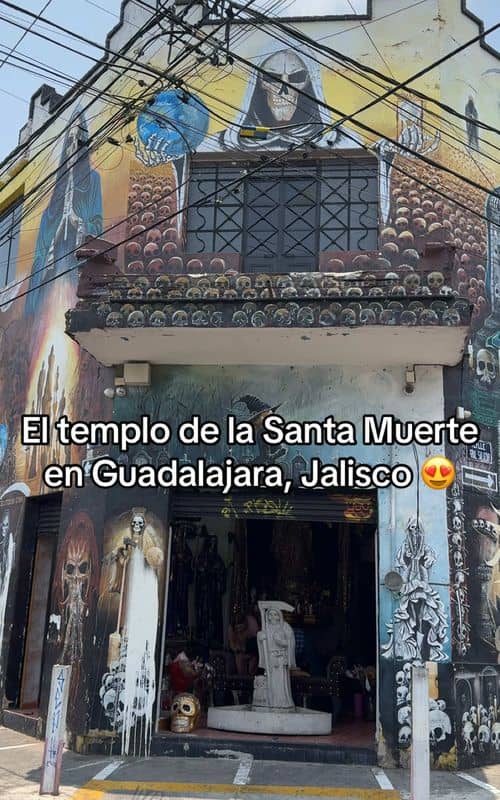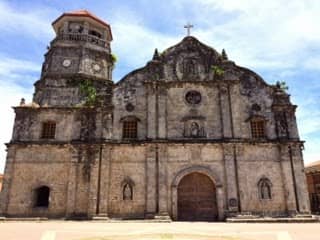Templo de Santa Mónica
A stunning example of baroque architecture, Templo de Santa Mónica in Guadalajara and Puebla holds deep religious and cultural significance.

Highlights
Must-see attractions

Social
From TikTok & Reddit
Best Time
Festival for Señor de las Maravillas
Templo de Santa Mónica
Best Time
Festival for Señor de las Maravillas

Highlights
Must-see attractions
A stunning example of baroque architecture, Templo de Santa Mónica in Guadalajara and Puebla holds deep religious and cultural significance.
"An amazing facade that is recently restored."
Confirm Opening Hours
Some visitors found it closed unexpectedly. Call ahead or check local listings to avoid disappointment.
Admire Facade Details
Take time to appreciate the intricate art and recent restoration work on the facade.
Highlights
Discover the most iconic attractions and experiences

Baroque Architecture
Admire the stunning baroque and novohispanic architectural details of this historic temple.
Señor de las Maravillas
This revered image draws thousands of faithful, especially during its July celebration.

Restored Facade
The recently restored facade showcases the intricate artistry and historical significance of the building.
Plans like a pro.
Thinks like you
Planning Your Visit
Timing is Key for Santa Mónica
Appreciate the Details
Best Times
Insider Tips
from TikTok, Instagram & Reddit
Confirm Opening Hours
Some visitors found it closed unexpectedly. Call ahead or check local listings to avoid disappointment.
Admire Facade Details
Take time to appreciate the intricate art and recent restoration work on the facade.
Check for Events
Special religious events and processions can be a highlight, but may affect access.
Respectful Attire
As a place of worship, dress modestly when visiting the temple.
Tips
from all over the internet
Confirm Opening Hours
Some visitors found it closed unexpectedly. Call ahead or check local listings to avoid disappointment.
Admire Facade Details
Take time to appreciate the intricate art and recent restoration work on the facade.
Check for Events
Special religious events and processions can be a highlight, but may affect access.
Respectful Attire
As a place of worship, dress modestly when visiting the temple.
What Travellers Say
Reviews Summary
Visitors praise the beautiful baroque architecture and intricate facade details, with some noting recent restorations enhance its appeal. However, a recurring point is the unpredictability of opening hours, with some finding the temple closed unexpectedly. The devotion surrounding the Señor de las Maravillas in Puebla is also a significant draw.
"Very nice barrock architecture. Unfortunately closed when we were there."
Kai Griebenow
"It's a beautiful temple small but it's open all day ,"
Rosa De la cruz
"Take a look in front art details ..."
Cleverson Tabajara Vianna
What People Like
What People Dislike
Frequently Asked Questions
🚇 🗺️ Getting There
The Templo de Santa Mónica is located in the historic center of Guadalajara, Jalisco. It's accessible by public transport, including local buses and taxis. Many visitors find it convenient to walk if they are already exploring the city center.
Yes, the Templo de Santa Mónica in Puebla is situated in the city's historic center, making it accessible by foot from many central attractions. Local buses and taxis are also readily available.
Parking in historic city centers can be challenging. It's advisable to look for public parking lots or garages nearby rather than street parking, especially in Guadalajara and Puebla.
Absolutely! Many historical walking tours of Guadalajara and Puebla include stops at significant religious sites like the Templo de Santa Mónica, offering guided insights into its history and architecture.
These are two distinct locations in different cities. Travel between Guadalajara and Puebla typically involves long-distance buses or flights.
🎫 🎫 Tickets & Entry
Generally, entry to the Templo de Santa Mónica is free, as it is a place of worship. However, donations are often appreciated to help with maintenance and preservation.
Opening hours can vary. Some sources suggest it's open all day, while others recommend confirming locally as it may close unexpectedly. It's best to check with the parish or local tourist information.
While general entry is usually free, special religious events or festivals might have associated activities or areas that could involve a small fee or donation.
Temples are typically open on Sundays for religious services. It's advisable to check the specific service schedule if you plan to visit on a Sunday to ensure you can also explore the architecture.
Photography is usually permitted for personal use, but it's always respectful to avoid flash photography, especially during services. Some areas might have specific restrictions.
🎫 🏛️ Onsite Experience
The Templo de Santa Mónica is renowned for its beautiful baroque and novohispanic architecture, featuring intricate facades and detailed interiors.
The Señor de las Maravillas is a highly venerated image in Puebla, drawing thousands of devotees for its annual celebration on July 6th and its participation in Holy Week processions.
While official guided tours might not always be available, local guides or knowledgeable parishioners may offer insights. Exploring the details of the architecture yourself is also highly rewarding.
The festival involves crowds of faithful, flowers, music, and a strong sense of devotion. Many people wear purple to honor the image.
Absolutely. The temple is a significant example of colonial religious art and architecture, offering a rich experience for art history enthusiasts.
📸 📸 Photography
The intricately detailed facade is a prime subject. Inside, focus on the altar, architectural elements, and any religious art. Be mindful of lighting and respectful of worshippers.
Photography of the Señor de las Maravillas is generally allowed, but always be discreet and avoid flash, especially during services or processions.
While generally permitted for personal use, avoid using flash photography, especially during religious services. Some areas might have specific signage indicating no-photo zones.
Morning light can be beautiful for the facade, while late afternoon might offer softer light. Consider visiting during events for unique photographic opportunities, but be prepared for crowds.
Drone usage is typically restricted in urban areas and around religious sites due to privacy and safety concerns. It's best to assume drones are not permitted unless explicitly stated otherwise.
For Different Travelers
Tailored advice for your travel style
👨👩👧 Families with Kids
Practical tips for families: Ensure children understand the need for quiet and respectful behavior inside the temple. Consider visiting during off-peak hours to avoid large crowds and allow children more space to observe. If possible, look for any informational plaques or guides that can make the history more accessible and interesting for younger minds.
🙏 Devout Visitors
In Guadalajara, the Virgen de la Medalla Milagrosa is also a focus of devotion. Visitors can find a peaceful atmosphere for prayer and reflection within the temple's sacred spaces. Remember to dress modestly and be mindful of ongoing religious services to ensure a respectful visit.
🏛️ Architecture & History Buffs
For history enthusiasts, understanding the temple's role in local religious and cultural life is key. The story of the Señor de las Maravillas in Puebla, for instance, is deeply intertwined with the city's identity. The mention of a recovered stolen artifact also points to the ongoing efforts to preserve cultural heritage, adding another layer of historical interest.
Deep Dives
In-depth insights and expert knowledge
Architectural Significance
One notable aspect mentioned is the ferrocemento roofing, a technique associated with architect Felix Candela, suggesting modern architectural interventions or influences in some parts of the structure or related buildings. This blend of historical and potentially modern architectural elements makes the Templo de Santa Mónica a fascinating site for those interested in the evolution of Mexican architecture.
Beyond its aesthetic appeal, the temple's architecture often reflects its religious and historical context. The layout, ornamentation, and scale are designed to inspire awe and devotion, serving as a central point for community and spiritual life. Exploring these structures offers a glimpse into the cultural and religious history of the regions where they are located.
Devotion to Señor de las Maravillas
The most prominent celebration occurs annually on July 6th, when the temple becomes a focal point for a massive pilgrimage. Devotees, many dressed in purple, gather to offer prayers, flowers, and express their gratitude for miracles and solace attributed to the image. The event is often accompanied by music and a vibrant atmosphere, reflecting a deep-rooted tradition and a strong community bond.
The Señor de las Maravillas also plays a crucial role in the religious calendar of Puebla, notably closing the procession on Holy Friday. This tradition underscores the image's importance in the city's spiritual life and its connection to significant religious observances. The devotion to the Señor de las Maravillas is more than just a tradition; it represents a profound connection between history, art, and faith that continues to thrive in Puebla.
Cultural Heritage and Preservation
Recent restorations, such as the one on the facade in Guadalajara, demonstrate a commitment to maintaining these historical sites for future generations. Such preservation efforts are crucial for safeguarding the architectural beauty and historical narratives embedded within these temples. They ensure that the baroque architecture and the stories they hold remain accessible and appreciated.
Visiting these temples offers a chance to connect with Mexico's rich history and artistic traditions. They serve as reminders of the enduring power of faith, art, and community, making them essential stops for anyone interested in Mexican culture and history.


Social
from TikTok, Instagram & Reddit